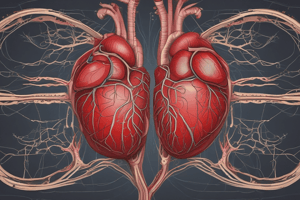Podcast
Questions and Answers
What is the primary function of the cardiovascular system?
What is the primary function of the cardiovascular system?
- To regulate body temperature
- To transport oxygen, nutrients, and waste products throughout the body (correct)
- To produce hormones that regulate growth
- To filter waste and excess fluids from the blood
What is the average weight of the human heart?
What is the average weight of the human heart?
- 150-200 grams
- 400-500 grams
- 250-350 grams (correct)
- 350-400 grams
What type of cells are found in cardiac muscle?
What type of cells are found in cardiac muscle?
- Smooth muscle cells
- Epithelial cells
- Striated, multinucleate cells
- Branching striated, uninucleate cells (correct)
What is the purpose of the mitral valve in the heart?
What is the purpose of the mitral valve in the heart?
What type of respiration do cardiac muscle cells primarily rely on to generate energy?
What type of respiration do cardiac muscle cells primarily rely on to generate energy?
What is the function of gap junctions in cardiac muscle cells?
What is the function of gap junctions in cardiac muscle cells?
What is the primary function of the pulmonary circulation?
What is the primary function of the pulmonary circulation?
Which of the following vessels carries oxygen-rich blood away from the heart?
Which of the following vessels carries oxygen-rich blood away from the heart?
What is the purpose of the coronary circulation?
What is the purpose of the coronary circulation?
What is the primary function of capillaries?
What is the primary function of capillaries?
What is the main role of the cardiovascular system?
What is the main role of the cardiovascular system?
Which of the following structures is responsible for pumping oxygen-poor blood from the right atrium to the right ventricle?
Which of the following structures is responsible for pumping oxygen-poor blood from the right atrium to the right ventricle?
Flashcards are hidden until you start studying
Study Notes
The Cardiovascular System: A Comprehensive Guide
The cardiovascular system, also known as the circulatory system, is a complex network of organs and vessels that work together to transport oxygen, nutrients, and waste products throughout the body. It consists of the heart, which serves as a pump, and a vast network of blood vessels, including arteries, veins, and capillaries.
The Heart
The heart is a muscular organ that functions as a pump, weighing between 250-350 grams and located in the mediastinum. It has four chambers, essentially dividing it into two sides of two-chamber circuits: the left side chambers supply the systemic circulation, and the right side chambers supply the pulmonary circulation. The left-sided chambers are separated by the mitral (bicuspid) valve, while the right-sided chambers are divided by the tricuspid valve.
Cardiac Muscle
Cardiac muscle cells are branching striated, uninucleate cells that contain myofibrils. They are connected by intercalated discs containing desmosomes and gap junctions, which enable electrical coupling action and allow the myocardium to behave as a functional syncytium. Cardiac muscle cells have abundant mitochondria, which depend on aerobic respiration primarily to generate adenosine triphosphate (ATP), the molecule that provides energy for cellular function.
Systemic Circulation
The systemic circulation originates in the left side of the heart and is responsible for supplying oxygen-laden blood to all organs of the human body. Oxygen-rich blood is pumped to the body's organs through the aortic semilunar valve.
Pulmonary Circulation
The pulmonary circulation is located on the right side of the heart and serves the function of gas exchange. Oxygen-poor systemic blood reaches the right atrium via three major venous structures: the superior vena cava, inferior vena cava, and coronary sinus. This blood is then pumped down to the right ventricle via the tricuspid valve and eventually through the pulmonic valve, leading to the pulmonary trunk.
Coronary Circulation
Coronary circulation is the circulation to the heart organ itself. It is supplied by the right and left coronary arteries, which branch from the ascending aorta. These arteries provide oxygen-rich blood to the heart muscle tissue during the heart relaxation phase.
Vessel Anatomy
The cardiovascular system includes arteries, capillaries, and veins. Arteries carry blood away from the heart, while veins transport blood back to the heart. Arteries are subdivided into larger conducting arteries, smaller distributing arteries, and the smallest arteries, known as arterioles, which supply the capillary bed. Capillaries are microscopic vessels that provide a site of gas, ion, nutrient, and waste exchange with tissues and organs.
The cardiovascular system is crucial for maintaining homeostasis, providing oxygen and nutrients to cells and organs, and removing waste products. It is regulated by a variety of stimuli, including changing blood volume, hormones, electrolytes, osmolarity, medications, adrenal glands, kidneys, and the parasympathetic and sympathetic nervous systems.
Studying That Suits You
Use AI to generate personalized quizzes and flashcards to suit your learning preferences.





